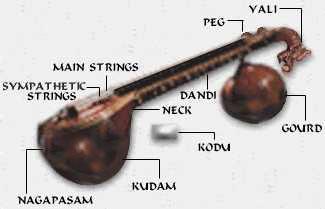Sangeetanubhava
CHITRAVINA
The Chitravina is one of the most ancient instruments with the reputation of being the closest to the human voice. From a distance it looks very similar to the Vina, but varies in the fact that it doesn't have frets and is played with a cylindrical piece of black wood or these days, teflon. Having gone out of vogue for several centuries, it was brought back to the performing stage by Tiruvidaimarudur Sakharama Rao, who called it the 'Gotuvadyam', 'gotu' referring to the cylindrical piece of wood and 'vadyam', meaning instrument. This tradition was carried on by his disciple 'Gotuvadyam' Narayana Iyengar, who did a lifetime of research and gave it the structure, scope and stature that it occupies today. He introduced a layer of 12 sympathetic strings at the bottom and also standardized the pitch and other little features which make the Chitravina unique.
Construction: It is structured exactly like the Vina, but without the frets and the wax ledge. In addition, there are sympathetic strings, which form the lower layer, a distinguishing feature. Usually made of jack wood, the Chitravina has a total of 21 strings, which are divided thus - six strings on the upper layer, which are the main playing strings, three strings on the side for tala / drone strings just as in the Vina and 12 sympathetic strings beneath the main strings.
Tuning: The six main strings are in clusters. The first three, closest to the artiste are one cluster, tuned to the basic Sa, the Adhara Shadja. The next two which form the next cluster are tuned to the lower Pa and the Pa an octave lower than that. The last string is tuned to the lower Sa. Of the 12 sympathetic strings, 4 are tuned to Sa, three to Pa, and the other five to Ri, Ga, Ma, Da and Ni, depending on the raga. However, this is a flexible arrangement. The side strings are tuned just like the Vina. The usual pitch is between 5 and 5 1/2 (G and G#).
